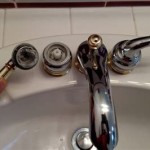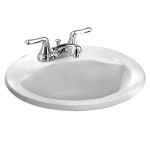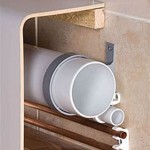How To Clean Ring Around Bathroom Sink
The unsightly ring around the bathroom sink, a common household nuisance, is caused by a buildup of soap scum, minerals from hard water, and personal care products. Removing this stubborn residue requires specific cleaning techniques and products tailored to the sink's material. Regular cleaning prevents buildup and maintains a sparkling, hygienic bathroom.
Understanding the Ring
The composition of the ring varies depending on water hardness and product usage. Hard water deposits contain calcium and magnesium ions that react with soap, forming a stubborn film. Soap scum combines with body oils, lotions, and toothpaste to contribute to the ring's tenacity. Recognizing the ring's components helps in selecting the most effective cleaning method.
Cleaning Solutions for Different Sink Materials
Different sink materials react differently to cleaning agents. Porcelain, ceramic, and vitreous china are durable and can withstand mildly abrasive cleaners. However, harsh chemicals can damage their surfaces over time. Acrylic and fiberglass sinks require gentler cleaning methods to avoid scratching. Natural stone sinks, like marble and granite, are porous and susceptible to staining and etching from acidic cleaners. Always test any cleaning solution on an inconspicuous area before applying it to the entire sink.
Effective Cleaning Methods
Several cleaning methods are available for tackling the ring around the bathroom sink. Choosing the right one depends on the severity of the buildup and the sink material. Baking soda, a mild abrasive, is excellent for scrubbing away grime. White vinegar, a natural cleaner, effectively dissolves mineral deposits. Commercial bathroom cleaners provide a convenient option, but ensure they are compatible with the sink material. Microfiber cloths are ideal for cleaning and polishing as they are gentle yet effective.
Step-by-Step Cleaning Guide
Start by rinsing the sink with warm water to remove loose debris. Sprinkle baking soda around the ring and gently scrub with a damp sponge or microfiber cloth. For tougher stains, make a paste of baking soda and water. Spray the sink with white vinegar and let it fizz for a few minutes. Rinse thoroughly with water and buff dry with a clean cloth. For persistent rings, repeat the process or use a commercial bathroom cleaner following the manufacturer's instructions.
Preventing Future Buildup
Preventing the ring from forming is easier than removing it. Regular cleaning, even a quick wipe down after each use, significantly reduces buildup. Keeping the sink dry after use minimizes the opportunity for minerals and soap to settle and harden. Squeegeeing the sink after each use helps remove excess water. Consider using a daily shower spray to prevent soap scum and hard water stains. Installing a water softener can reduce mineral deposits in hard water areas.
Natural Cleaning Alternatives
For those seeking eco-friendly options, several natural cleaning alternatives exist. Lemon juice, similar to vinegar, can dissolve mineral deposits. Castile soap, a gentle and biodegradable soap, effectively removes grime. A mixture of baking soda and essential oils, such as tea tree or lavender, cleans and deodorizes the sink. These natural alternatives provide effective cleaning power while minimizing the use of harsh chemicals.
Maintaining a Sparkling Bathroom Sink
Maintaining a consistently clean bathroom sink requires a combination of regular cleaning and preventative measures. Incorporating a quick cleaning routine into daily habits, such as wiping down the sink after each use, prevents major buildup. Using appropriate cleaning solutions for the sink material ensures longevity and maintains its shine. Implementing preventative measures, like using a daily shower spray or installing a water softener, minimizes future ring formation.
Common Cleaning Mistakes to Avoid
Avoid using abrasive cleaners or scrub brushes on delicate sink materials like acrylic or fiberglass, as these can cause scratches. Never mix bleach and ammonia, as this combination creates toxic fumes. Avoid letting acidic cleaners sit on natural stone surfaces for prolonged periods, as this can cause etching. Always rinse cleaning solutions thoroughly to prevent residue buildup. Proper cleaning techniques and product selection are essential for maintaining the integrity of the sink.
Choosing the Right Tools
Choosing the correct cleaning tools is crucial for effective cleaning and preventing damage. Microfiber cloths are gentle yet effective at removing grime and polishing surfaces. Soft sponges are suitable for scrubbing without scratching. Avoid using abrasive scrub brushes, especially on delicate sink materials. A spray bottle is useful for applying cleaning solutions evenly. Using the right tools combined with the correct cleaning methods ensures an efficient and damage-free cleaning process.

Say Goodbye To Ring Around The Drain Bella Carina

How To Clean Ring Around Sink Drain 2 Ways Tested What Works

How To Clean Ring Around Sink Drain 2 Ways Tested What Works

How To Clean A Clogged Sink Remove Stopper

How To Get Rid Of Iron And Rust Stains Once For All Water Right

Where Do You Get Those Pink Stains In Your Bathroom

How To Clean Ring Around Kitchen Sink Drain Tiktok Search

How Did I Get Rust Stains In My Sink Benjamin Franklin Dallas

How To Care For Porcelain Fixtures

Mineral Deposits Joyful Homemaking
Related Posts







